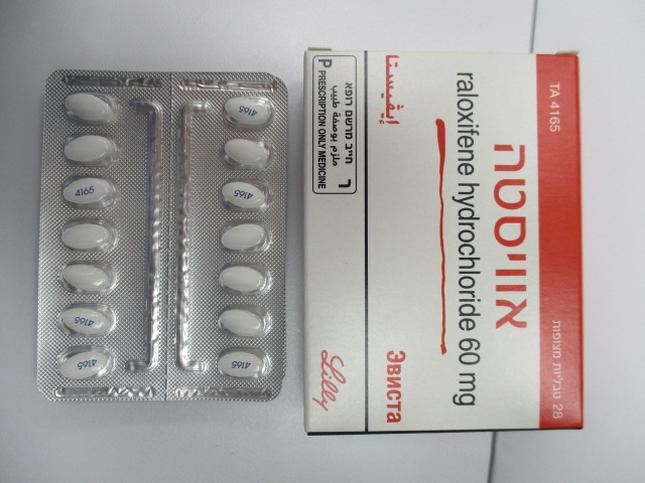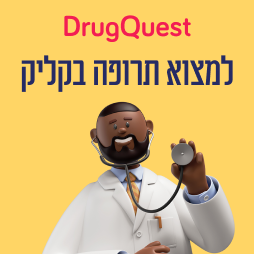Quest for the right Drug

אוויסטה EVISTA (RALOXIFENE HYDROCHLORIDE)
תרופה במרשם
תרופה בסל
נרקוטיקה
ציטוטוקסיקה
צורת מתן:
פומי : PER OS
צורת מינון:
טבליות מצופות פילם : FILM COATED TABLETS
עלון לרופא
מינוניםPosology התוויות
Indications תופעות לוואי
Adverse reactions התוויות נגד
Contraindications אינטראקציות
Interactions מינון יתר
Overdose הריון/הנקה
Pregnancy & Lactation אוכלוסיות מיוחדות
Special populations תכונות פרמקולוגיות
Pharmacological properties מידע רוקחי
Pharmaceutical particulars אזהרת שימוש
Special Warning עלון לרופא
Physicians Leaflet
Adverse reactions : תופעות לוואי
6 ADVERSE REACTIONS 6.1 Clinical Trials Experience Because clinical studies are conducted under widely varying conditions, adverse reaction rates observed in the clinical trials of a drug cannot be directly compared to rates in the clinical trials of another drug and may not reflect the rates observed in practice. The data described below reflect exposure to EVISTA in 8429 patients who were enrolled in placebo-controlled trials, including 6666 exposed for 1 year and 5685 for at least 3 years. Osteoporosis Treatment Clinical Trial (MORE) — The safety of raloxifene in the treatment of osteoporosis was assessed in a large (7705 patients) multinational, placebo-controlled trial. Duration of treatment was 36 months, and 5129 postmenopausal women were exposed to raloxifene hydrochloride (2557 received 60 mg/day, and 2572 received 120 mg/day). The incidence of all-cause mortality was similar among groups: 23 (0.9%) placebo, 13 (0.5%) EVISTA-treated (raloxifene 60 mg), and 28 (1.1%) raloxifene 120 mg women died. Therapy was discontinued due to an adverse reaction in 10.9% of EVISTA-treated women and 8.8% of placebo- treated women. Venous Thromboembolism: The most serious adverse reaction related to EVISTA was VTE (deep venous thrombosis, pulmonary embolism, and retinal vein thrombosis). During an average of study-drug exposure of 2.6 years, VTE occurred in about 1 out of 100 patients treated with EVISTA. Twenty-six EVISTA-treated women had a VTE compared to 11 placebo-treated women, the hazard ratio was 2.4 (95% confidence interval, 1.2, 4.5), and the highest VTE risk was during the initial months of treatment. Common adverse reactions considered to be related to EVISTA therapy were hot flashes and leg cramps. Hot flashes occurred in about one in 10 patients on EVISTA and were most commonly reported during the first 6 months of treatment and were not different from placebo thereafter. Leg cramps occurred in about one in 14 patients on EVISTA. Placebo-Controlled Osteoporosis Prevention Clinical Trials — The safety of raloxifene has been assessed primarily in 12 Phase 2 and Phase 3 studies with placebo, estrogen, and estrogen-progestin therapy control groups. The duration of treatment ranged from 2 to 30 months, and 2036 women were exposed to raloxifene HCl (371 patients received 10 to 50 mg/day, 828 received 60 mg/day, and 837 received from 120 to 600 mg/day). Therapy was discontinued due to an adverse reaction in 11.4% of 581 EVISTA-treated women and 12.2% of 584 placebo- treated women. Discontinuation rates due to hot flashes did not differ significantly between EVISTA and placebo groups (1.7% and 2.2%, respectively). Common adverse reactions considered to be drug-related were hot flashes and leg cramps. Hot flashes occurred in about one in four patients on EVISTA versus about one in six on placebo. The first occurrence of hot flashes was most commonly reported during the first 6 months of treatment. Table 1 lists adverse reactions occurring in either the osteoporosis treatment or in five prevention placebo-controlled clinical trials at a frequency ≥2.0% in either group and in more EVISTA-treated women than in placebo-treated women. Adverse reactions are shown without attribution of causality. The majority of adverse reactions occurring during the studies were mild and generally did not require discontinuation of therapy. Table 1: Adverse Reactions Occurring in Placebo-Controlled Osteoporosis Clinical Trials at a Frequency ≥2.0% and in More EVISTA-Treated (60 mg Once Daily) Women than Placebo-Treated Womena Treatment Prevention EVISTA Placebo EVISTA Placebo N=2557 N=2576 N=581 N=584 % % % % Body as a Whole Infection A A 15.1 14.6 Flu Syndrome 13.5 11.4 14.6 13.5 Headache 9.2 8.5 A A Leg Cramps 7.0 3.7 5.9 1.9 Chest Pain A A 4.0 3.6 Fever 3.9 3.8 3.1 2.6 Cardiovascular System Hot Flashes 9.7 6.4 24.6 18.3 Migraine A A 2.4 2.1 Syncope 2.3 2.1 B B Varicose Vein 2.2 1.5 A A Digestive System Nausea 8.3 7.8 8.8 8.6 Diarrhea 7.2 6.9 A A Dyspepsia A A 5.9 5.8 Vomiting 4.8 4.3 3.4 3.3 Flatulence A A 3.1 2.4 Gastrointestinal Disorder A A 3.3 2.1 Gastroenteritis B B 2.6 2.1 Metabolic and Nutritional Weight Gain A A 8.8 6.8 Peripheral Edema 5.2 4.4 3.3 1.9 Musculoskeletal System Arthralgia 15.5 14.0 10.7 10.1 Myalgia A A 7.7 6.2 Arthritis A A 4.0 3.6 Tendon Disorder 3.6 3.1 A A Nervous System Depression A A 6.4 6.0 Insomnia A A 5.5 4.3 Vertigo 4.1 3.7 A A Neuralgia 2.4 1.9 B B Hypesthesia 2.1 2.0 B B Respiratory System Sinusitis 7.9 7.5 10.3 6.5 Rhinitis 10.2 10.1 A A Bronchitis 9.5 8.6 A A Pharyngitis 5.3 5.1 7.6 7.2 Cough Increased 9.3 9.2 6.0 5.7 Pneumonia A A 2.6 1.5 Laryngitis B B 2.2 1.4 Skin and Appendages Rash A A 5.5 3.8 Sweating 2.5 2.0 3.1 1.7 Special Senses Conjunctivitis 2.2 1.7 A A Urogenital System Vaginitis A A 4.3 3.6 Urinary Tract Infection A A 4.0 3.9 Cystitis 4.6 4.5 3.3 3.1 Leukorrhea A A 3.3 1.7 Uterine Disorderb, c 3.3 2.3 A A Endometrial Disorderb B B 3.1 1.9 Vaginal Hemorrhage 2.5 2.4 A A Urinary Tract Disorder 2.5 2.1 A A a A: Placebo incidence greater than or equal to EVISTA incidence; B: Less than 2% incidence and more frequent with EVISTA. b Includes only patients with an intact uterus: Prevention Trials: EVISTA, n=354, Placebo, n=364; Treatment Trial: EVISTA, n=1948, Placebo, n=1999. c Actual terms most frequently referred to endometrial fluid. Comparison of EVISTA and Hormone Therapy — EVISTA was compared with estrogen-progestin therapy in three clinical trials for prevention of osteoporosis. Table 2 shows adverse reactions occurring more frequently in one treatment group and at an incidence ≥2.0% in any group. Adverse reactions are shown without attribution of causality. Table 2: Adverse Reactions Reported in the Clinical Trials for Osteoporosis Prevention with EVISTA (60 mg Once Daily) and Continuous Combined or Cyclic Estrogen Plus Progestin (Hormone Therapy) at an Incidence ≥2.0% in any Treatment Groupa Hormone Therapy-Continuous EVISTA Combinedb Hormone Therapy-Cyclicc (N=317) (N=96) (N=219) % % % Urogenital Breast Pain 4.4 37.5 29.7 d 6.2 64.2 88.5 Vaginal Bleeding Digestive Flatulence 1.6 12.5 6.4 Cardiovascular Hot Flashes 28.7 3.1 5.9 Body as a Whole Infection 11.0 0 6.8 Abdominal Pain 6.6 10.4 18.7 Chest Pain 2.8 0 0.5 a These data are from both blinded and open-label studies. b Continuous Combined Hormone Therapy = 0.625 mg conjugated estrogens plus 2.5 mg medroxyprogesterone acetate. c Cyclic Hormone Therapy = 0.625 mg conjugated estrogens for 28 days with concomitant 5 mg medroxyprogesterone acetate or 0.15 mg norgestrel on Days 1 through 14 or 17 through 28. d Includes only patients with an intact uterus: EVISTA, n=290; Hormone Therapy-Continuous Combined, n=67; Hormone Therapy-Cyclic, n=217. Breast Pain — Across all placebo-controlled trials, EVISTA was indistinguishable from placebo with regard to frequency and severity of breast pain and tenderness. EVISTA was associated with less breast pain and tenderness than reported by women receiving estrogens with or without added progestin. Gynecologic Cancers — EVISTA-treated and placebo-treated groups had similar incidences of endometrial cancer and ovarian cancer. Placebo-Controlled Trial of Postmenopausal Women at Increased Risk for Major Coronary Events (RUTH) — The safety of EVISTA (60 mg once daily) was assessed in a placebo-controlled multinational trial of 10,101 postmenopausal women (age range 55- 92) with documented coronary heart disease (CHD) or multiple CHD risk factors. Median study drug exposure was 5.1 years for both treatment groups [see Clinical Studies (14.3)]. Therapy was discontinued due to an adverse reaction in 25% of 5044 EVISTA-treated women and 24% of 5057 placebo-treated women. The incidence per year of all-cause mortality was similar between the raloxifene (2.07%) and placebo (2.25%) groups. Adverse reactions reported more frequently in EVISTA-treated women than in placebo-treated women included peripheral edema (14.1% raloxifene versus 11.7% placebo), muscle spasms/leg cramps (12.1% raloxifene versus 8.3% placebo), hot flashes (7.8% raloxifene versus 4.7% placebo), venous thromboembolic events (2.0% raloxifene versus 1.4% placebo), and cholelithiasis (3.3% raloxifene versus 2.6% placebo) [see Clinical Studies (14.3, 14.5)]. Tamoxifen-Controlled Trial of Postmenopausal Women at Increased Risk for Invasive Breast Cancer (STAR) — The safety of EVISTA 60 mg/day versus tamoxifen 20 mg/day over 5 years was assessed in 19,747 postmenopausal women (age range 35-83 years) in a randomized, double-blind trial. As of 31 December 2005, the median follow-up was 4.3 years. The safety profile of raloxifene was similar to that in the placebo-controlled raloxifene trials [see Clinical Studies (14.4)]. 6.2 Postmarketing Experience Because these reactions are reported voluntarily from a population of uncertain size, it is not always possible to reliably estimate their frequency or establish a causal relationship to drug exposure. Adverse reactions reported very rarely since market introduction include retinal vein occlusion, stroke, and death associated with venous thromboembolism (VTE). Reporting suspected adverse reactions after authorisation of the medicinal product is important. It allows continued monitoring of the benefit/risk balance of the medicinal product. Any suspected adverse events should be reported to the Ministry of Health according to the National Regulation by using an online form https://sideeffects.health.gov.il

פרטי מסגרת הכללה בסל
הוראות לשימוש בתרופות ALENDRONATE SODIUM, RISEDRONATE SODIUM, RALOXIFENE, BAZEDOXIFENE:א. התרופות האמורות יינתנו לטיפול באוסטיאופורוזיס ובהתאם לכללים האלה: 1. למטופלות בכל מקרה של אוסטיאופורוזיס: א. עם שבר אוסטיאופורוטי קיים או בנוכחות תולדות של שבר אוסטיאופורוטי; ב. עם T score (ההפרש בין צפיפות העצם של המטופל לבין צפיפות העצם הממוצעת לאדם באוכלוסיה) השווה ל-3.5 או הנמוך מ-3.5- ;ג. בנשים מעל גיל 60 שנים עם T score השווה ל-2.5 או הנמוך מ-2.5- ;ד. שנגרם מאחת המחלות הידועות כגורמות לו; ה. בכל מקרה של אוסטיאופורוזיס שנגרם כתוצאה מטיפול בתכשיר גלוקוקורטיקואידי. 2. למטופלים בכל מקרה של אוסטיאופורוזיס: א. עם שבר אוסטיאופורוטי קיים או בנוכחות תולדות של שבר אוסטיאופורוטי; ב. מעל גיל 60 עם T score השווה ל-2.5 או הנמוך מ-2.5-; ג. בכל מקרה של אוסטיאופורוזיס שנגרם כתוצאה מטיפול בתכשיר גלוקוקורטיקואידי;. ד. שנגרם מאחת המחלות הידועות כגורמות לו; 3. התרופות יינתנו למטופלים ומטופלות בהתאם לחלוקה זו: א. ALENDRONATE SODIUM, RISEDRONATE SODIUM - למטופלים ולמטופלות;ב. RALOXIFENE, BAZEDOXIFENE - למטופלות בלבד.2. אף אחת מן התרופות האמורות לא תינתן בשילוב עם התרופות האחרות.
מסגרת הכללה בסל
התוויות הכלולות במסגרת הסל
| התוויה | תאריך הכללה | תחום קליני | Class Effect | מצב מחלה |
|---|---|---|---|---|
| למטופלים בכל מקרה של אוסטיאופורוזיס | RALOXIFENE, BAZEDOXIFENE |
שימוש לפי פנקס קופ''ח כללית 1994
לא צוין
תאריך הכללה מקורי בסל
01/01/2000
הגבלות
תרופה מוגבלת לרישום ע'י רופא מומחה או הגבלה אחרת
מידע נוסף
